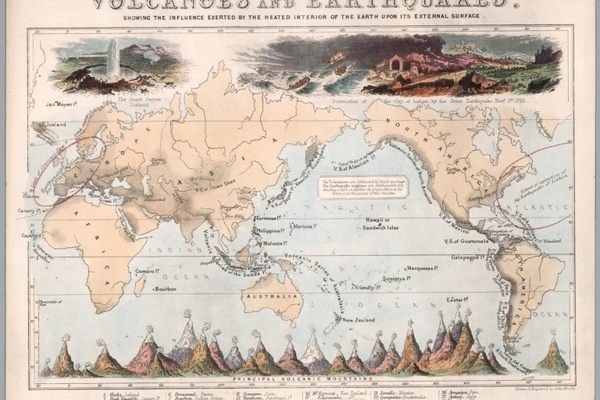A 19th-Century Map of Our ‘Square and Stationary’ Earth
How could the world be spinning? Wouldn’t we fall off?
(Image: Library of Congress/2011594831)
According to Orlando Ferguson we are not living on a globe but in a giant donut mold.
In 1893, Ferguson, of Hot Springs, South Dakota, published his Map of the Square and Stationary Earth. It depicts the world spread over a basin with a mound in the middle. Lining the rim of the basin is the jagged coast of Antarctica, which forms the icy edge of the world. The sun and moon are depicted as rotating lamps suspended at the end of arc-shaped arms rooted in the Arctic.
This geography is inventive enough to be fascinating in itself, but then there is what lies beyond the icy edge. Ferguson chose to extend the perimeter to form a square shape, and placed an angel at each corner. This detail was inspired by a phrase in the opening sentence of Revelations 7: “four angels standing at the four corners of the earth, holding back the four winds.”

Ferguson including other relevant passages of scripture beneath the map in an effort to bolster his flat-Earth argument. On the right side, he included an image of two men clinging to a rapidly rotating, globe-shaped Earth. Such a thing, he contended, must be impossible.

Considering Pythagoras cottoned on to the spherical Earth thing around 500 BCE, and that, by the Middle Ages, the prevailing view was that we live on a globe, 1893 seems pretty late in the game to be producing a map of the world as a square, stationary chunk. But Orlando Ferguson wasn’t a lone voice. The latter half of the 19th century had seen a resurgence of the flat-Earth movement.
In 1885, for example, William Carpenter of Baltimore published One Hundred Proofs that the Earth is Not a Globe. The list of not-quite-proofs includes “the Moon’s beams are cold” and “it is the star that moves.” Twenty years earlier, English writer Samuel Rowbotham had published a book titled Zetetic Astronomy: Earth Not a Globe! It includes a run-down of experiments “proving the Earth to be a Plane.”
Originals of Ferguson’s flat-Earth map are scarce, but one lives on at the Library of Congress, and another at the Pioneer Museum in Ferguson’s hometown of Hot Springs, South Dakota. The flat-Earth movement also endures, spearheaded by the small but determined Flat Earth Society.
Map Monday highlights interesting and unusual cartographic pursuits from around the world and through time. Read more Map Monday posts.





















Follow us on Twitter to get the latest on the world's hidden wonders.
Like us on Facebook to get the latest on the world's hidden wonders.
Follow us on Twitter Like us on Facebook